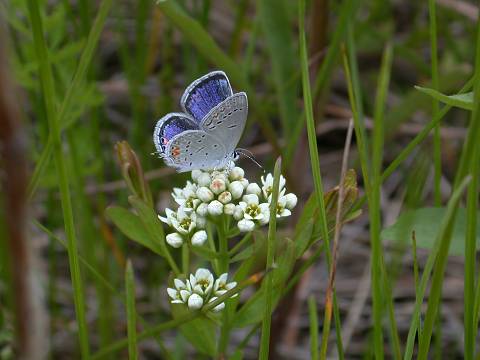

Comandra umbellata - (image 1 of 7)
Taxonomy
Family: Santalaceae
Habitat
Oak savanna, dune, prairie and prairie fens.
Associates
In sandy soil found with Andropogon scoparius, Arabis lyrata, Aster azureus, Arctostaphylos uva-ursi, Euphorbia corollata, Liatris aspera, Phlox pilosa, Tradescantia ohioensis.
Distribution
Various subspecies cover most of North America.
Morphology
Simple or branched perennial to 40 cm. Leaves oblong, subopposite, lighter on the underside. Flowers small, perfect, epigynous, in compact, terminal, cymose-paniculiform inflorescence; petals lacking (?); sepals (tepals?) 5, white to greenish; hypanthium well developed.
Notes
Flowers late April into July
Wetland indicator: Facultative Upland
Semi-parasitic on the roots of other plants. The flowers seem to attract eastern tailed-blues (Everes comyntas). These little gems rub their hind wings together continuously when at rest (image 7), which made getting the first picture a real challenge.
References
Gleason, Henry A. and A. Cronquist. 1991. Manual of Vascular Plants of
Northeastern United States and Adjacent Canada. Second Ed.
The New York Botanical Garden. Bronx, NY
Swink, F. and G. Wilhelm. 1994. Plants of the Chicago Region.
Indiana Academy of Science. The Morton Arboretum. Lisle, Illinois.
|
Michael Hough © 2004 |